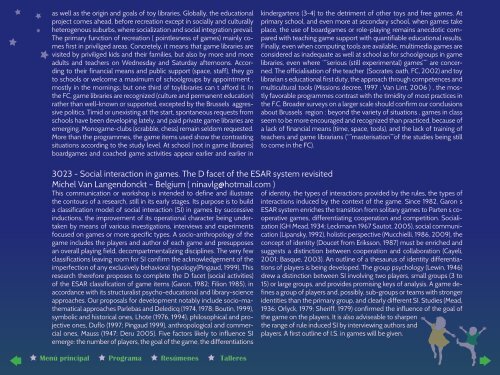Programa completo do Congresso - Associação Brasileira de ...
Programa completo do Congresso - Associação Brasileira de ...
Programa completo do Congresso - Associação Brasileira de ...
Create successful ePaper yourself
Turn your PDF publications into a flip-book with our unique Google optimized e-Paper software.
as well as the origin and goals of toy libraries. Globally, the educational<br />
project comes ahead, before recreation except in socially and culturally<br />
heterogenous suburbs, where socialization and social integration prevail.<br />
The primary function of recreation ( pointlesness of games) mainly comes<br />
first in priviliged areas. Concretely, it means that game libraries are<br />
visited by priviliged kids and their families, but also by more and more<br />
adults and teachers on Wednesday and Saturday afternoons. According<br />
to their financial means and public support (space, staff), they go<br />
to schools or welcome a maximum of schoolgroups by appointment ,<br />
mostly in the mornings; but one third of toylibraries can t afford it. In<br />
the FC, game libraries are recognized (culture and permanent education)<br />
rather than well-known or supported, excepted by the Brussels aggressive<br />
politics. Timid or unexisting at the start, spontaneous requests from<br />
schools have been <strong>de</strong>veloping lately, and paid private game libraries are<br />
emerging. Monogame-clubs (scrabble, chess) remain sel<strong>do</strong>m requested.<br />
More than the programmes, the game items used show the contrasting<br />
situations according to the study level. At school (not in game libraries)<br />
boardgames and coached game activities appear earlier and earlier in<br />
3023 - Social interaction in games. The D facet of the ESAR system revisited<br />
Michel Van Langen<strong>do</strong>nckt – Belgium ( ninavlg@hotmail.com )<br />
This communication or workshop is inten<strong>de</strong>d to <strong>de</strong>fine and illustrate<br />
the contours of a research, still in its early stages. Its purpose is to build<br />
a classification mo<strong>de</strong>l of social interaction (SI) in games by successive<br />
inductions, the improvement of its operational character being un<strong>de</strong>rtaken<br />
by means of various investigations, interviews and experiments<br />
focused on games or more specific types. A socio-anthropology of the<br />
game inclu<strong>de</strong>s the players and author of each game and presupposes<br />
an overall playing field, <strong>de</strong>compartmentalizing disciplines. The very few<br />
classifications leaving room for SI confirm the acknowledgement of the<br />
imperfection of any exclusively behavioral typology(Pingaud, 1999). This<br />
research therefore proposes to complete the D facet (social activities)<br />
of the ESAR classification of game items (Garon, 1982; Filion 1985), in<br />
accordance with its structuralist psycho-educational and library-science<br />
approaches. Our proposals for <strong>de</strong>velopment notably inclu<strong>de</strong> socio-mathematical<br />
approaches Parlebas and Deledicq (1974, 1978; Boutin, 1999),<br />
symbolic and historical ones, Lhote (1976, 1994), philosophical and projective<br />
ones, Duflo (1997; Pingaud 1999), anthropological and commercial<br />
ones, Mauss (1947; Deru 2005). Five factors likely to influence SI<br />
emerge: the number of players, the goal of the game, the differentiations<br />
Menú principal <strong>Programa</strong> Resúmenes Talleres<br />
kin<strong>de</strong>rgartens (3-4) to the <strong>de</strong>triment of other toys and free games. At<br />
primary school, and even more at secondary school, when games take<br />
place, the use of boardgames or role-playing remains anec<strong>do</strong>tic compared<br />
with teaching game support with quantifiable educational results.<br />
Finally, even when computing tools are available, multimedia games are<br />
consi<strong>de</strong>red as ina<strong>de</strong>quate as well at school as for schoolgroups in game<br />
libraries, even where “”serious (still experimental) games”” are concerned.<br />
The officialisation of the teacher (Socrates oath, FC, 2002) and toy<br />
librarian s educational first duty, the approach through competences and<br />
multicultural tools (Missions <strong>de</strong>cree, 1997 ; Van Lint, 2006 ) , the mostly<br />
favorable programmes contrast with the timidity of most practices in<br />
the F.C. Broa<strong>de</strong>r surveys on a larger scale should confirm our conclusions<br />
about Brussels region : beyond the variety of situations , games in class<br />
seem to be more encouraged and recognized than practiced, because of<br />
a lack of financial means (time, space, tools), and the lack of training of<br />
teachers and game librarians (“”masterisation””of the studies being still<br />
to come in the FC).<br />
of i<strong>de</strong>ntity, the types of interactions provi<strong>de</strong>d by the rules, the types of<br />
interactions induced by the context of the game. Since 1982, Garon s<br />
ESAR system enriches the transition from solitary games to Parten s cooperative<br />
games, differentiating cooperation and competition. Socialization<br />
(GH Mead, 1934; Leckmann 1967 Sautot, 2005), social communication<br />
(Lipansky, 1992), holistic perspective (Mucchielli, 1986, 2009), the<br />
concept of i<strong>de</strong>ntity (Doucet from Eriksson, 1987) must be enriched and<br />
suggests a distinction between cooperation and collaboration (Cayeli,<br />
2001; Basque, 2003). An outline of a thesaurus of i<strong>de</strong>ntity differentiations<br />
of players is being <strong>de</strong>veloped. The group psychology (Lewin, 1946)<br />
drew a distinction between SI involving two players, small groups (3 to<br />
15) or large groups, and provi<strong>de</strong>s promising keys of analysis. A game <strong>de</strong>fines<br />
a group of players and, possibly, sub-groups or teams with stronger<br />
i<strong>de</strong>ntities than the primary group, and clearly different SI. Studies (Mead,<br />
1936; Orlyck, 1979; Sheriff, 1979) confirmed the influence of the goal of<br />
the game on the players. It is also adviseable to sharpen<br />
the range of rule induced SI by interviewing authors and<br />
players. A first outline of I.S. in games will be given.


